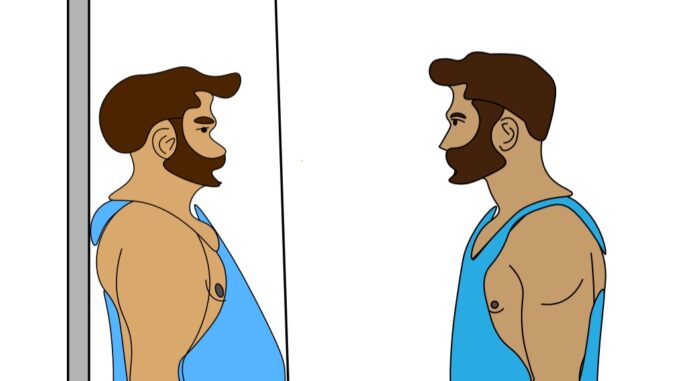
design: Carissa Long and Brooke Farren
From Flappers to Kardashians and James Dean to Harry Styles, society’s idea of the perfect body has changed entirely over time.
For decades, boys and girls have been forced to face the struggles of body image. Teens, adolescents and even adults struggle with accepting how their body looks. As time has passed, the media has become one of the biggest influences on people today. However, what’s being projected by the media in regards to dieting, exercise and the overall care of one’s body has negatively impacted generations.
It is hard to see the negative effects any form of media is giving because it’s what’s being seen every day: it’s the norm. The media encourages consumers to use detox drinks, dieting and intense workouts as different ways to get the slimmest and built bodies with images of unrealistic outcomes because everybody is different.
Parker Huston, a clinical director at Nationwide Children’s, shared that the media is the single biggest contributor to false body ideals. He said that these media standards project into teenagers’ social media pages as they edit and alter their bodies and use filters.
Ohio State University Women’s Gender and Sexuality Studies Professor Linda Mizeijewski agrees, and said the media most often chooses to show “cookie cutter” women with slim, healthy bodies.
“Ideal female bodies, the ones who become media stars and influencers, remain thin, white, young and without obvious disabilities,” Mizeijewski said.
Nothing seems wrong with showing women as perfect at first, but it can affect women who read the magazines or media in a negative way.
“Social media affects women by portraying that one needs to be perfect,” AP Psychology teacher Laura Carder said. Posts showing women as thin can sometimes cause “eating and psychological disorders” to women looking at these “perfect” women, according to Carder.
Although the media can alter the definition of a perfect body, it looks different to everyone, including senior Clara Storer.
“I have never let the way I look at my body change my routines, but I have at times questioned if I fully loved my body. However, I took the time to learn the importance of loving and appreciating your body so I know I do now,” Storer said.
The media does not allow for all women to positively self evaluate, though. For example, some feel as if they should change their lifestyle so that they look exactly like the people they see in the media or change their hobbies and preferences so they act like them, which can lead to certain disorders.
“Such images may be good for some plastic surgeons but can’t be good for the body image, self-confidence (unless you are Jessica Rabbit), eating habits and other behaviors of girls and women,” “How Media Portrayal Affects Women, And What Geena Davis Is Doing About It”, according to Forbes.com.
The media also tend to show female models wearing certain clothes that fit certain body types, which then causes women to start trends by buying and wearing the clothes that the model was wearing. People who don’t have access or the money to get those clothing styles, or the body type to wear them feel left out and can get discouraged; it might even get to the point where women might be ready to do anything so that they can fit into those clothes.
“Bodies in media promote and sell not just diet products and exercise regimes but also the fashions that show us what our bodies are supposed to look like,” Mizeijewski said. “The point is to make us buy products that will change our bodies and our looks.”
Body image is much less talked about among men than it is with women, and although the messages are different between genders, the impact that the media’s gender roles have on men are very real.
Assistant Professor of Women’s & Gender Studies at Bucknell University Dr. Erica Delsandro laid out the basic stereotypes men see most often in the media.
“The mainstream media overwhelming portrays ‘successful’ men as strong, muscular, unafraid, heterosexual, with tendencies towards violence and emotional repression. Because of this dominant characterization — called hegemonic masculinity, many men internalize specific messages about what ‘real’ men do and what ‘real’ men look like,” Delsandro said.
Senior Jack Sullivan said he has noticed these suggestions of the perfect man in advertisements.
“I feel like it’s far and few between that I see either a plus size or even just a slightly chubby guy in ads or on TV,” Sullivan said, “Men are always styled to have perfect hair, perfect bodies, etc just like women are; the only reason it’s never brought up is because men are supposed to not be sensitive.”
LGBTQ underrepresentation in media is another less-discussed factor of body image in today’s society. It is getting better, though, as within the last several years, the media showing more LGBTQ individuals has helped many people ease their way into a transition.
“Because of the ‘feeling of safety’ that trans individuals felt as a result of societal gains,
more were willing to share their stories, which also contributed to a sort of informal education on trans issues for those willing to listen to said stories,” Berkshire Middle School Guidance
counselor Drew Rock said.
Many different aspects of society have contributed to these changes, particularly the
media. It’s how a large portion of the population is exposed to the lifestyle of transgender people and the transgender body.
According to the Director of Programs for Transgender Media at the Gay & Lesbian
Alliance Against Defamation (GLAAD) Nick Adams, “Though the number of
Americans who say, that they personally know someone who is transgender has grown, 84
percent of Americans continue to learn about transgender people through the media.”
Therefore, it’s crucial that the media increase and improve the coverage of transgender issues, and that transgender people have the opportunity to tell their own stories about (their) lives and the issues (they) face,” according to glaad.org.
The Media’s Effect on Body Image with Older Generations
Media have affected the body images of different demographics throughout history, even in older generations. While they may not have had media as such a large influence in the past, they still had television, radio and magazines to see and hear unrealistic expectations of body image. Lisa Finneran, a member of the school community, shared how as a young adolescent she yearned for the day she looked like an Olympic athlete.
“When I was younger, television and magazines that were in my home had a great influence on what I saw as a perfect body. I constantly saw women with very athletic and muscular figures, and I wanted the same. I really wanted to run track, and the summer that the Olympics were televised gave me a chance to see so many strong and athletic women. All I wanted was to look like them,” Finneran said.
As generations have passed, the ideal body image for men and women have constantly evolved according to Huston.
“Male body image has not changed nearly as drastically as for females. The expectations are like a rollercoaster instead of a linear change”, Huston said.
“In the early 1900s, women were expected to be full-figured but that changed by the 1920s, when being thin (flappers) became stylish. The expectations reverted back to a more typical body ratio in the 1940s-1960s, then being thin became more fashionable again.
“These periods (the 1920s and 1980s) are also the periods with the highest prevalence of eating disorders in the country. These days, it seems to be less about hip-waist-bust ratio and more about muscle definition and fitness,” he said.
Potential Problems of a Poor Body Image
All of these unattainable goals for body image can lead to mental as well as physical problems. For example, the media’s tendency to portray ideal men as muscular and athletically fit leads to encouraging the use of supplements to get bigger, which can be dangerous.
Sociology teacher Leslie Hosgood labeled this as a potential serious problem for many men.
“The rise of eating disorders in men can be at least in part linked to the marketing of weight gain/loss ‘supplements’ and general depictions of the ‘ideal male body’ as being incredibly muscular. These supplements are often ineffective and sometimes even unsafe,” Hosgood said.
The unsafe effects of the media on body image isn’t always physical, either. Many men have developed eating disorders through poor body image, yet are afraid to say anything about it due to the stigma around mental illness. It’s not ‘manly’ to have body issues, or eating disorders, causing men to have trouble letting others know they’re going through these issues.
“The number of men who have eating disorders has increased at an alarming rate. This observation connects to my previous comments about mental health because some men do not seek treatment for eating disorders because of the stigma,” Hosgood said.
The National Eating Disorder Association supports this, saying that males represent 25 percent of individuals with anorexia and are at a higher risk of dying due to often being diagnosed later, as many people assume males don’t have eating disorders.
Another problem the media promotes is rigid body standards through television, especially in underrepresenting transgender characters. Recently, though, the number of LGBTQ characters has grown and is higher than ever before according to a study by GLAAD. However, it’s not always in good light, as many times transgender people are vilanized.
“The organization GLAAD explains in their article, “Victims or Villains: Examining Ten
Years of Transgender Images on Television” that transgender individuals, if included in media,
are often portrayed as victims in situations they are put in and stereotyped often in writing.
This is a very serious issue, as it plays into the way in which society perceives the trans community and may negatively affect the way in which people view this community in their day-to-day lives,” Olentangy High School English teacher and Gender and Sexualities Alliance Adviser Morgan Thornberry said.
A poor body image can have a huge effect socially, in our interactions with others, resulting in both social and professional losses, according to Professor Delsandro.
“Unhealthy body image can restrict a person’s behavior: social and professional choices, for example. If someone has a healthy body image, they are likely to take opportunities more readily — be they social or professional,” Delsandro said.
Current Trends With Body Image
Throughout all forms of media, the transgender body is often shown as a perfect body that could be unattainable for many. With more knowledge and light shining on the transgender community a larger variety of body types are being shown.
“Social media and magazines are historically notorious for depicting stereotypical ideal
body images, polarizing masculinity and femininity. I think there has been a push for body
positive or more realistic representation for the full spectrum of humans represented in the media over the past several years,” Guidance Counselor Heather Smith said.
The media’s views are slowly changing even now, as people from different cultures and backgrounds as well as people who are born different, are starting to become more recognized.
“It’s wonderful that Beyonce has become an icon, but most icons are not women of color,” Professor Mizeijewski said. “Along the same lines, it’s a good sign that Lizzo has been embraced as a positive image, but we can still count on one hand the number of female stars who look like Lizzo.”
The Effects of Peers on Body Image
These standards received from the media have a large impact, but that only goes so far. Peers and friend groups can also impact body image as well. Surrounding oneself with people who only think negatively about their bodies can change one’s perception of their body.
Both Storer and Finneran have done well not letting their close friends’ opinions reflect onto them. They have learned over the years the value of self love and acceptance of their bodies regardless of how they look.
“My peers are all built very differently: some tall, some short, some athletic, some not, but this has never been something that has affected the way they see their body image or the way I see mine,” Storer said. “The biggest way peers influence body image is by saying anything about anyone’s body. Hearing someone talk about their biggest insecurity confirms and contributes to a poor self body image.
“It’s important to appreciate your body and try your best to not let social media or your peers affect the way you see your body.”
“I have learned to embrace the good parts and not focus on what I don’t love because you are given one body and you need to accept that, and treat it well. Respecting yourself should come first,” Finneran said.
Director of Women’s studies at Kent State University Suzanne Holt offers one solution to the body image problem. Although the media may not change anytime soon, not only can one’s mindset on their body change, but also how we view body image as a whole.
“Individuals who successfully work their body image into the bigger picture of self and self image tend to put the body where it should be: it’s not everything; it’s certainly not nothing. It’s something though. This is a subject that requires all of us to pause and realize. An image is just an image. It’s re-create-able,” Holt said.


